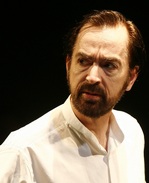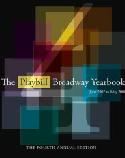SITE GUIDE
SEARCH
REVIEWS
REVIEW ARCHIVES
ADVERTISING AT CURTAINUP
FEATURES
NEWS
Etcetera and
Short Term Listings
LISTINGS
Broadway
Off-Broadway
NYC Restaurants
BOOKS and CDs
OTHER PLACES
Berkshires
London
California
New Jersey
DC
Philadelphia
Elsewhere
QUOTES
TKTS
PLAYWRIGHTS' ALBUMS
LETTERS TO EDITOR
FILM
LINKS
MISCELLANEOUS
Free Updates
Masthead
A CurtainUp Review
Prisoner of the Crown
By Elyse Sommer
|
I can arrest you under the Defence of the Realm Act. —Hearn Are poets now considered a threat to the realm, Sergeant? — Casement In time of war, anyone who goes swimming before breakfast can be a threat. —Hearn Must we go over it all again? Just for you? —one of the impatient jurors. It's a man's life. . .— the uncertain juror played by the actor who also plays the man on trial. |

Philip Goodwin in Prisoner of the Crown
(Photo: Carol Rosegg) |
Written by Richard F. Stockton, with additional material and concept credited to Richard T. Herd, the play dramatizes the trial of Sir Roger Casement (1864-1916). The Irishman, who was knighted in 1911 by the British for his work in exposing and ending the mistreatment of Congolese natives, just five years later found himself tried for high treason after a trip to Germany to secure a treaty that would guarantee Irish independence after the war. His arrest "outside the realm" put him under the military jurisdiction, which made hanging him a problem. But those determined to hang him were not above dirty tricks and managed to get the trial shifted from a court marshal to the Old Bailey arguing that "treason is treason. Wherever it happens."
Not content with the machinations and abuses in these anything's fair in war procedure, the powers that be further muddied the rules of law by publicizing Casement's private diaries. Thus, even twenty years after Oscar Wilde's imprisonment for "the love that dare not speak its name," intolerance about such things remained deeply ingrained. The trial for high treason became fodder for the scandal sheets and the diaries, though their authenticity was never proved, helped to tie the knot in the noose around Casement's neck.
And so we have a play without possibility for a surprise ending. Since the prisoner's fate known from the outset, it behooves the playwright, director and actors to engage the audience with pleasures other than suspense about the trial's conclusion. Fortunately, such pleasures are abundantly present in this production, not the least being the incisive, often eerily relevant, dialogue. The vivid staging and acting makes Casement's journey to the gallows exciting and disturbingly suspenseful despite the predictable ending and a few somewhat overly stylized intra scene flourishes.
As he did with his revival of Eugene O'Neill's The Hairy Ape, Ciarán O'Reilly has mounted the play with an expressionist flair that accomodates eight different locations. These include the Old Bailey, a German prisoner of War camp, the Tower of London's Cell 4 where two young royals were famously killed and the hangman's holding cell. Quite a challenge for this small a theater, but actually a plus since it lends itself to the stylized representation of three jurors as empty suits with bowler hats and the surreal choreography used to shift from scene to scene. One of the most effectively staged scene shifts depicts Casement's humiliating strip search as a shadow play behind a huge sheet draped around him. That sheet then becomes a projection screen for images of Casement along with photos of the Congolese atrocities he exposed and was knighted for.
As O'Reilly and his design team have gracefully turned the tight playing area into a triumph of stagecraft, so the extensive multiple role playing has been made into an asset, with one actor often slyly cast to play like-minded characters; for example, Philip Goodwin not only plays the title character, but the juror who insists on letting his conscience be his guide. Thus as Casement, weakened by cruel and inhuman imprisonment in the Tower of London, allows himself to be bamboozled into being tried at the Old Bailey instead of by his current captors so the hold-out juror he plays is ultimately railroaded into a guilty vote. The jurors through whose minds the key events are enacted also play other characters who reflect the opinions expressed during their deliberation.
Patrick Fitzgerald, who inhabits a handful of roles, is most often and amusingly onstage as a one-man chorus whose wry commentary is a winking nod to the ironic similarities between the events on stage and those more recently in the news. He opens the play by strolling around the stage looking over the set. Then, as if becoming aware of the audience for the first time, he takes them into his confidence, explaining that what they're about to see is how there was nothing special about an Irish patriot ("—-or an English traitor—-take your pick —") to be the very last knight of the British realm ever to be hanged for high treason since there were "plenty of dead Irish to choose from." But with a quick wink, he establishes that Casement's case was something special since it raised the question of whether treason was the true cause or the juror played by Goodwin was right to insist that " It's nobody's business what he is with his pants down. In public, he's a bloody giant! A better man than any here. "
As both trial defendant and most thoughtful juror, Philip Goodwin is very much the giant of this ensemble. The rest of the cast is amazingly versatile in the 46 other roles. If there's a standout besides Goodwin, it's John Windsor-Cunningham who's an especially fine villainous Attorney-General to Goodwin's noble Knight—as well as a gung-ho to convict juror.
Fitzgerald's Welsh chorus character is consistently droll, ending the play as he begins it with a teasing "it's comforting to know that all this was long ago. And that high-muckety-mucks today--yours and mine--would never think of engaging in such skullduggery as that." We may not all leave the Irish Rep comforted by that thought, but it is a comfort to know that this worthy little theater keeps proving that thoughtful, quality theater experiences are not necessarily limited to big, glitzy Broadway shows.
|
PRISONER OF THE CROWN by Richard F. Stockton with additional material and original concept by Richard T. Herd Directed by Ciarán O'Reilly Cast: Peter Cormican, Patrick Fitzgerald, Philip Goodwin, Emma O'Donnell, Tim Ruddy, Ian Stuart, John Vennema, and John Windsor-Cunningham. Set Design by Charles Corcoran Costume Design by David Toser Lighting Design by Brian Nason Sound Design by Zachary Williamson Wig and Hair Design by Robert-Charles Vallance Fight Director: Rick Sordelet. Dialect Coach: Stephen Gabis Aerieal Effects: Paul Rubin Stage Manager: leslie Grisdale Running Time: 2hours and 10 minutes, includes one intermission The Irish Repertory Theatre,132 West 22nd St. 212/255-0270 x22 or www.irishrep.org. From 5/14/08; opening 5/22/08; closing 7//06/08. Wednesday — Saturday at 8 PM. Matinees are Wednesday, Saturday, and Sunday at 3 PM. Tickets are $60 and $55 Reviewed by Elyse Sommer May 22nd matinee |
|
REVIEW FEEDBACK Highlight one of the responses below and click "copy" or"CTRL+C"
Paste the highlighted text into the subject line (CTRL+ V): Feel free to add detailed comments in the body of the email. |
Try onlineseats.com for great seats to
Wicked
Jersey Boys
The Little Mermaid
Lion King
Shrek The Musical

Leonard Maltin's 2008 Movie Guide

Playbill 2007-08 Yearbook


Wicked
Jersey Boys
The Little Mermaid
Lion King
Shrek The Musical

Leonard Maltin's 2008 Movie Guide

Playbill 2007-08 Yearbook


